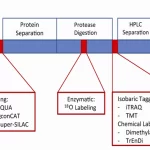
What is Proteomics
July 7, 2019What is proteomics?
Proteomics is the large-scale study of proteins.
Brief definition
The term “proteomics” was first coined in 1995 and was defined as the large-scale characterization of the entire protein complement of a cell line, tissue, or organism.
Today, two definitions of proteomics are encountered. The first is the more classical definition, restricting the large-scale analysis of gene products to studies involving only proteins.
The second and more inclusive definition combines protein studies with analyses that have a genetic readout such as mRNA analysis, genomics, and the yeast two-hybrid analysis.
However, the goal of proteomics remains the same, i.e., to obtain a more global and integrated view of biology by studying all the proteins of a cell rather than each one individually.
What is proteome?
A proteome is a set of proteins produced in an organism, system, or biological context. We may refer to, for instance, the proteome of a species (for example, Homo sapiens) or an organ (for example, the liver). The proteome is not constant; it differs from cell to cell and changes over time. To some degree, the proteome reflects the underlying transcriptome, however protein activity is also modulated by many factors in addition to rates of production.

Why Proteomics?
Many types of information cannot be obtained from the study of genes alone. For example, proteins, not genes, are responsible for the phenotypes of cells. It is impossible to elucidate mechanisms of disease, aging, and effects of the environment solely by studying the genome. Only through the study of proteins can protein modifications be characterized and the targets of drugs identified.

Proteomics is used to investigate:
(i) when and where proteins are expressed;
(ii) rates of protein production, degradation, and steady-state abundance;
(iii) how proteins are modified (for example, post-translational (iv) modifications (PTMs) such as phosphorylation);
(v) the movement of proteins between subcellular compartments;
(vi) the involvement of proteins in metabolic pathways;
(vii) how proteins interact with one another.
Types of Proteomics
(i) Protein expression proteomics.
The quantitative study of protein expression between samples that differ by some variable is known as expression proteomics. In this approach, protein expression of the entire proteome or of subproteomes between samples can be compared. Information from this approach can identify novel proteins in signal transduction or identify disease-specific proteins.
(ii) Structural proteomics.
Proteomics studies whose goal is to map out the structure of protein complexes or the proteins present in a specific cellular organelle are known as “cell map” or structural proteomics. Structural proteomics attempts to identify all the proteins within a protein complex or organelle, determine where they are located, and characterize all protein-protein interactions. An example of structural proteomics was the recent analysis of the nuclear pore complex. Isolation of specific subcellular organelles or protein complexes by purification can greatly simplify the proteomic analysis. This information will help piece together the overall architecture of cells and explain how expression of certain proteins gives a cell its unique characteristics.
(iii) Functional proteomics.
“Functional proteomics” is a broad term for many specific, directed proteomics approaches. In some cases, specific subproteomes are isolated by affinity chromatography for further analysis. This could include the isolation of protein complexes or the use of protein ligands to isolate specific types of proteins. This approach allows a selected group of proteins to be studied and characterized and can provide important information about protein signaling, disease mechanisms or protein-drug interactions.
Common technologies
Fluorescence 2D Difference Gel Electrophoresis (2D-DIGE),Isotope-Coded Affinity Tag (ICAT),Stable Isotope Labeling with Amino Acids in Cell Culture (SILAC),18O Stable Isotope Labeling,Isobaric Tag for Relative and Absolute Quantitation (iTRAQ),MUDPIT,Protein array and Mass spectrometry.
Challenges
The study of proteins, in contrast to that of DNA, presents a number of unique challenges. For example, there is no equivalent of PCR for proteins, so the analysis of low-abundance proteins remains a major challenge. In addition, in protein interaction studies, native conformations of proteins must be maintained to obtain meaningful results.
Conclusion
Despite these limitations, proteomics, when combined with other complementary technologies such as molecular biology, has enormous potential to provide new insight into biology. The ability to study complex biological systems in their entirety will ultimately provide answers that cannot be obtained from the study of individual proteins or groups of proteins.
References:
1.Graves, P. R., & Haystead, T. A. (2002). Molecular biologist’s guide to proteomics. Microbiol. Mol. Biol. Rev., 66(1), 39-63.
2.Fields, S. (2001). Proteomics in genomeland. Science, 291(5507), 1221-1224.
3.Rappsilber, J., & Mann, M. (2002). What does it mean to identify a protein in proteomics?. Trends in biochemical sciences, 27(2), 74-78.

















